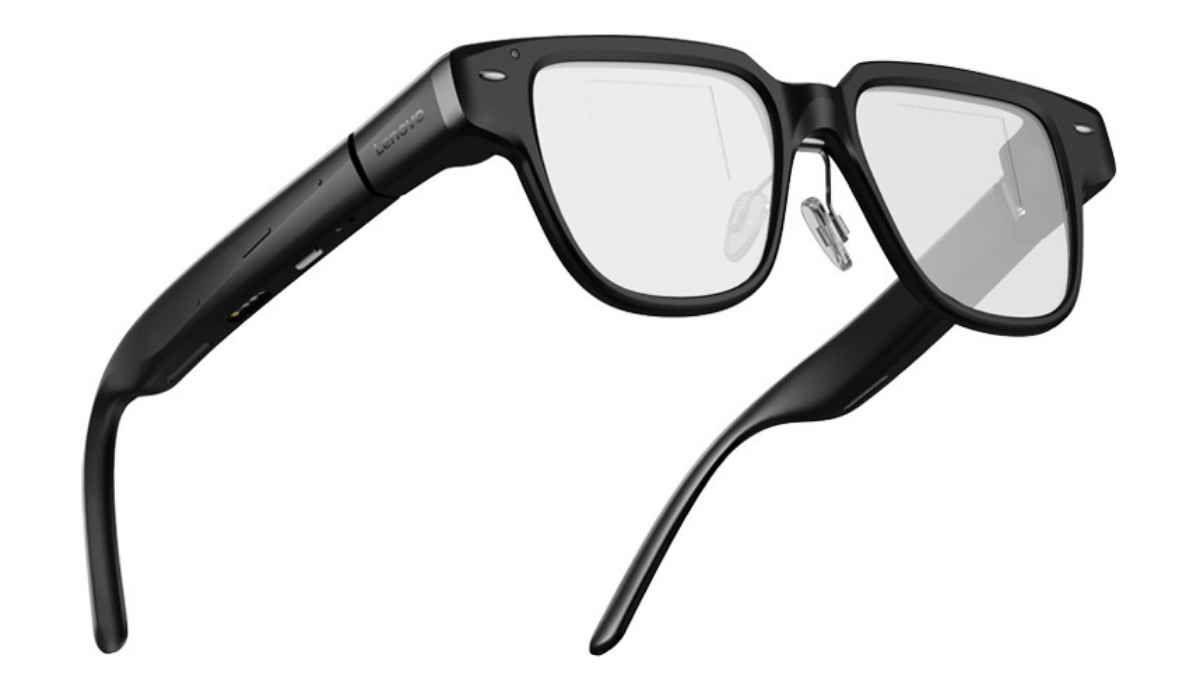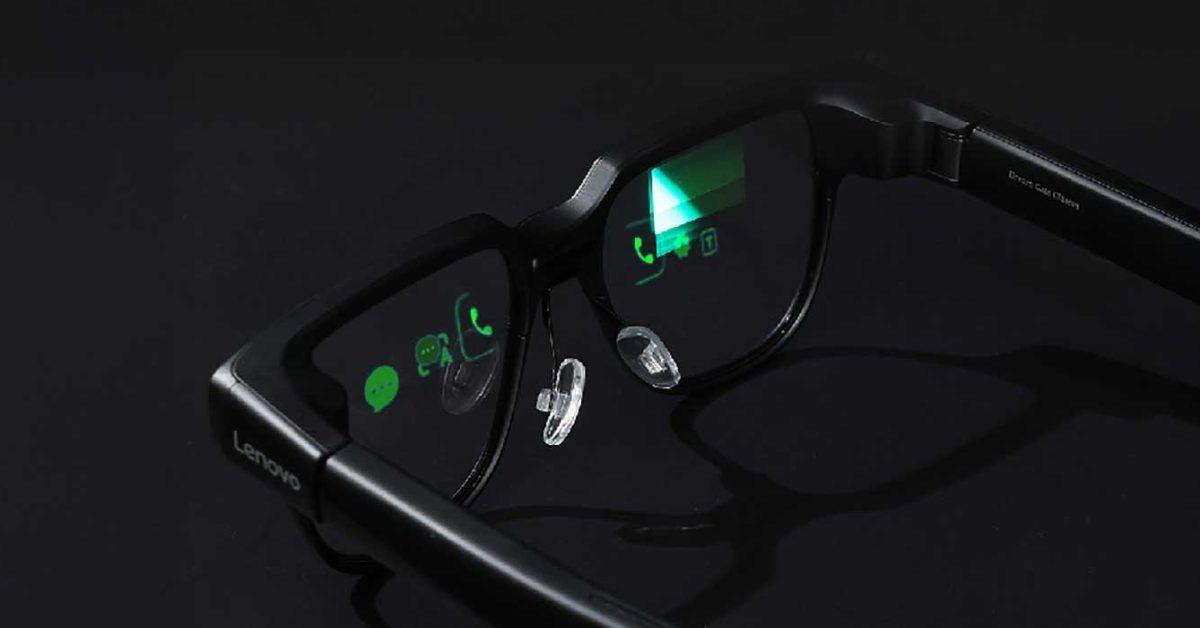Lenovo Unveils Ultra-Light AI Glasses V1 with Real-Time Translation and Camera-Free Design
5 Sources
5 Sources
[1]
Lenovo's V1 smart glasses skip the camera, but not AI
Lenovo is no stranger to glasses with new-age tech stuffed into them. However, this is the first pair of smart glasses with AI from the company, and they skip one of the most trendy features. AR glasses and smart glasses differ in some key ways. First, AR glasses don't really offer a comfortable everyday experience. Smart glasses beg to be worn for the majority of the day, and big releases like Ray-Ban's Meta glasses make the argument for content in view, always. Lenovo just announced the V1 smart glasses (via Notebookcheck). They take an approach similar to other glasses, like the Even Realities G1, or the Rokid Glasses. The V1 equips two sets of micro-LED displays that shine green text into your eyes - one in each lens. According to Lenovo, either or both displays can be used at the same time. The glasses have a set of speakers and a microphone to access Lenovo's in-house AI assistant. With that, users can pull up real-time translation and directions for walking or biking. There are sensors in the arms of the glasses, which allow for touch controls to swipe between features. What the Lenovo V1 glasses don't have is a camera, but that's probably fine. If Lenovo is aiming its glasses at professionals and tech enthusiasts, some may have no issue with the lack of camera sensors or recording capabilities. In contrast to Meta's glasses, these don't appear to be aimed at influencers and action-cam enthusiasts. Of course, features similar to Gemini Live wouldn't be possible, either. That would require a camera for the AI model to recognize and process data based on visual input. Lenovo says the V1 glasses will be available on November 9 for around CNY 3,999 ($560), which seems to be around the going rate for smart glasses right now. The V1's look to be aimed at a China release, though there doesn't seem to be much information on regional availability.
[2]
Lenovo unveils the world's lightest AI smart glasses
TL;DR: Lenovo introduces the AI Glasses V1, the lightest smart glasses at 36g and 1.8mm thickness, featuring a bright resin diffraction waveguide display and Tianxi AI assistant with voice commands and real-time translation. With up to 10 hours battery life, the V1 targets users seeking lightweight, functional AI eyewear. Lenovo has jumped into the AI smart glasses market with the unveiling of V1, a pair of smart glasses that are lighter than any other competitor. One of the biggest problems when it comes to smart glasses is the bulkiness that users have to endure, and while companies such as Meta are ironing out this issue with each new generation, AI smart glasses are generally still thicker and heavier than a traditional pair of reading glasses. This isn't surprising, given that AI smart glasses need to house all the necessary components within the glasses' frame, but the weight trade-off may outweigh the functionality they offer, making them a dealbreaker for some users. Lenovo is looking to scoop those users up with the AI Glasses V1, which come in at just 36g, making them lighter than the Rokid Glasses, which weigh 49 g. The V1 glasses are only 1.8mm thick and feature a resin diffraction waveguide display that has a peak brightness of 2,000 nits. Additionally, the V1 glasses support a 15 x 11 mm eye-box, which assists in keeping visuals stable as the user is moving their head. Users can also switch between monocular and binocular display modes. Moving to the software, Lenovo has integrated the Tianxi AI assistant into the glasses, which is capable of voice commands, real-time translation with on-screen text or voice, and information search. Furthermore, the V1 comes with microphones and speakers integrated directly into the frame of the glasses, and the ability to be linked to a smart ring accessory for creators who want to take advantage of the V1's teleprompter capabilities. Lenovo claims the V1 will last up to 10 hours when using the live translation feature, 4 hours in teleprompter mode, and 250 hours in standby. Charging time is estimated at around just 40 minutes from zero percent all the way to 100%. In an effort to make the lightest pair of AI smart glasses available, Lenovo has removed components such as the camera, which many competing wearables are built around, and significantly reduced the size of the battery. Lenovo has already begun selling the V1 in China for a price of CNY 3,999, which converts to about $562, and preorders are already open. The V1 is expected to become available in China on November 9. Currently, there is no word on when or if Lenovo plans to bring the V1 to Western markets.
[3]
Lenovo AI Glasses V1 Debuts With Real-Time Translation, Micro LED Displays
Wearers can switch to monocular and binocular modes in the wearable Lenovo AI Glasses V1 has been launched by the company in China. The smart glasses are touted to offer real-time AI prompts, navigation, and AI-powered translation. Weighing just 38g, the Lenovo AI Glasses V1 feature Micro LED displays with upto 2,000 nits peak brightness. It has dual microphones and speakers and includes the company's Tianxi assistant with support for voice commands, translation, and quick access to information. The Lenovo AI Glasses V1 is claimed to deliver up to 10 hours of battery life on a single charge. Lenovo AI Glasses V1 Price Lenovo AI Glasses V1 pricing is set at CNY 3,999 (roughly Rs. 49,000). It is currently available to pre-order in China via the company website, and shipments are scheduled to begin on November 18. The company is yet to announce any plans to bring the smart glasses to global markets. Lenovo AI Glasses V1 Specifications The Lenovo AI Glasses V1 resemble a pair of eyeglasses featuring sensors built into the frame. It is equipped with Micro LED displays and resin diffraction waveguide technology, delivering up to 2000 nits brightness and a 15×11mm eye-motion viewing range. It has dual speakers and dual microphones for audio and clear voice input. The smart glasses feature Lenovo's Tianxi intelligent assistant, and they provide Interactive AI translation, allowing users to translate foreign languages in real time. The company says that the Lenovo AI Glasses V1 is only 1.8mm thick and weighs 38g. It integrates with portable wireless earphones, enabling users to listen to music, read messages, scroll through content, and answer calls effortlessly with a simple tap. The Lenovo AI Glasses V1 come equipped with AI-powered navigation with visual and auditory guidance, though this feature is currently limited to Android devices. It also supports a wide range of AI features in AI voice interaction and AI prompting. The AI prompting feature, when paired with a smart ring, can assist in live presentations, speeches. Wearers can switch to monocular and binocular modes in the Lenovo AI Glasses V1. The smart glasses are advertised to deliver up to 250 hours of standby time and up to 10 hours of continuous translation time on a single charge. It is claimed to provide up to four hours of continuous teleprompter input.
[4]
Lenovo Launches New Visual AI Glasses V1 with Bright Display and Smart AI Voice Features
Lenovo's New Visual AI Glasses V1 Bring Real-Time Translation, Voice Control, and Accurate Navigation for Everyday Use Lenovo has launched its first pair of in China, called the Visual AI Glasses V1. This model is equipped with two bright microLED displays that show green visuals on both lenses. These displays can work together or one at a time, depending on the user's needs. The AI glasses are designed for easy and comfortable daily wear. The device weighs in at just 38 grams and has ultra-thin lenses with only 1.8 mm of thickness. The maximum brightness of the display is 2,000 nits, which signifies that the images will be visible even in bright sunlight. Lenovo says the design puts less pressure on the nose and ears, making them easy to wear for long hours.
[5]
Lenovo AI Glasses V1 with up to 2.6 hours of playback, up to 2000 nits of peak brightness launched in China: Price, specifications
Lenovo AI Glasses V1 is priced at CNY 3,999 (~Rs 50,000), and is China-only for now. Lenovo has launched the AI Glasses V1 in China, which is a pair of lightweight AI-powered smart glasses. It weighs only 38 grams and is lighter than previous Lenovo smart glasses. It is even lighter than the 48 g Rokid glasses, which are known as the lightest product of this kind. Besides the light build, the glasses also offer a resin-based waveguide display with up to 2,000 nits of peak brightness and up to 2.6 hours of media playback. Lenovo targets its new pair at users who want hands-free translation, on-screen prompts, and AI assistance in a compact form factor. Here are the details you need to know: The Lenovo AI Glasses V1 are available to pre-order in China for CNY 3,999 (about Rs 50,000). It will be available from 9 November on JD.com. Lenovo has not shared plans for global availability yet. Also Read: Samsung Galaxy XR vs Apple Vision Pro: Specs, features and key differences explained The AI Glasses V1 use a micro-LED panel paired with resin diffraction waveguide optics, a first in a consumer product, according to Lenovo. The display supports up to 2,000 nits peak brightness and a 15×11 mm eye-box range, helping maintain image stability even when the user moves. The glasses can operate in monocular or binocular view depending on the task. The frame weighs 38 g, lighter than the 48 g Rokid Glasses, the 70 g Meta Ray Ban glasses, and Lenovo's own ThinkReality A3, which weighed 130 grams. The new glasses feature 1.8 mm lenses, which are designed to reduce pressure on the nose and ears for longer use. Stereo speakers and dual microphones are built into the temple area for calls, audio prompts, and media playback. Controls are handled through touch panels on the sides. The glasses run Lenovo's Tianxi AI assistant. Features include live voice-and-text translation, conversation mode, a teleprompter screen for presenters, and AI-based navigation when paired with an Android phone. Translation mode lasts up to 10 hours on a single charge, while video playback drains the 167 mAh battery in roughly 2.6 hours at full brightness. A 40-minute charge cycle restores full battery, and standby time is rated at 250 hours. Connectivity is limited to Bluetooth 5.4, and the device does not include a camera, unlike its rivals, like Rokid and Meta Ray Ban glasses. So, the headline feature is the resin diffraction waveguide display, which Lenovo claims enables higher brightness and a thinner optical module than glass-based waveguides used by most AR wearables. The 2,000-nit brightness is also higher than Rokid's 1,500-nit dual-display setup, but not as bright as Meta Ray Ban glasses' claim of 5,000 nits. Still, the 2,000 nits brightness should aid in outdoor visibility. Teleprompter mode and visual live translation can come in handy in real-world use. The absence of a camera could, however, limit use in AR capture and remote-assist scenarios. Furthermore, the 2.6-hour playback time means these function more as a productivity tool than an entertainment headset. You will have to charge it to watch Nolan's Oppenheimer fully. Another thing to note is that AI navigation only works with Android for now. While it lacks mixed-reality capabilities, Lenovo could be positioning it for daily wear and utility. If Lenovo brings the AI Glasses V1 to global markets, pricing will determine whether they compete with creator-focused wearables like Meta Ray-Ban or productivity-plus-entertainment models like Xreal. We will be keeping tabs on Lenovo's plans on this front. Keep reading Digit.in for similar stories.
Share
Share
Copy Link
Lenovo launches the AI Glasses V1 in China, weighing just 36-38g and featuring micro-LED displays, real-time translation, and Tianxi AI assistant. The glasses prioritize lightweight design over camera functionality, targeting professionals and tech enthusiasts.
Lenovo Enters Smart Glasses Market with Ultra-Lightweight Design
Lenovo has officially launched its first AI-powered smart glasses, the V1, exclusively in China, marking the company's entry into the competitive smart glasses market with a unique approach that prioritizes lightweight design over camera functionality
1
. The glasses are positioned as the world's lightest AI smart glasses, weighing just 36-38 grams and measuring only 1.8mm in thickness2
.
Source: Digit
Technical Specifications and Display Technology
The V1 glasses feature dual micro-LED displays utilizing resin diffraction waveguide technology, a first in consumer products according to Lenovo
5
. The displays deliver up to 2,000 nits peak brightness with a 15×11mm eye-box range, ensuring image stability during head movement3
. Users can switch between monocular and binocular display modes depending on their needs, with green text projected directly into each lens1
.
Source: 9to5Google
The glasses integrate dual speakers and microphones directly into the frame's temple area, enabling hands-free audio interaction and calls
2
. Touch controls on the sides allow users to navigate between features with simple swipe gestures1
.AI Assistant and Core Features
The V1 glasses are powered by Lenovo's proprietary Tianxi AI assistant, offering voice commands, real-time translation capabilities, and information search functionality
3
. The translation feature supports both on-screen text and voice translation, making it particularly useful for international travelers and professionals working in multilingual environments4
.
Source: TweakTown
Additional features include AI-powered navigation with visual and auditory guidance, though this functionality is currently limited to Android devices
3
. The glasses also support teleprompter capabilities when paired with a smart ring accessory, targeting content creators and professionals who deliver presentations2
.Related Stories
Strategic Design Decisions and Market Positioning
Unlike competitors such as Meta's Ray-Ban smart glasses, Lenovo deliberately excluded camera functionality from the V1 design
1
. This decision appears aimed at professionals and tech enthusiasts who prioritize privacy and lightweight design over content creation capabilities. The absence of cameras also eliminates features like visual AI recognition that would require processing visual input .The V1's weight advantage is significant compared to competitors, coming in lighter than the 49-gram Rokid Glasses and substantially lighter than Meta's 70-gram Ray-Ban glasses
2
. This lightweight design reduces pressure on the nose and ears, making them suitable for extended daily wear4
.Battery Performance and Connectivity
The V1 glasses house a 167mAh battery that delivers varying performance depending on usage
5
. Real-time translation mode provides up to 10 hours of continuous use, while teleprompter mode offers approximately 4 hours of operation2
. Media playback at full brightness drains the battery in roughly 2.6 hours, with standby time rated at 250 hours5
.Charging is accomplished through a 40-minute cycle that restores full battery capacity
2
. Connectivity is limited to Bluetooth 5.4, reflecting the glasses' focus on essential functionality rather than comprehensive smart device integration5
.References
Summarized by
Navi
[1]
[2]
[4]
Related Stories
Xiaomi Challenges Meta with Advanced AI Smart Glasses
27 Jun 2025•Technology

Looktech AI Glasses: Revolutionizing Wearable Tech with Advanced AI Integration
12 Dec 2024•Technology

Rokid's AI Glasses Challenge Meta's Smart Eyewear Dominance with Advanced Features and Successful Crowdfunding
27 Aug 2025•Technology

Recent Highlights
1
Google launches Gemini 3 Flash as default AI model, delivering speed with Pro-grade reasoning
Technology

2
OpenAI launches GPT Image 1.5 as AI image generator war with Google intensifies
Technology

3
OpenAI launches ChatGPT app store, opening doors for third-party developers to build AI-powered apps
Technology





